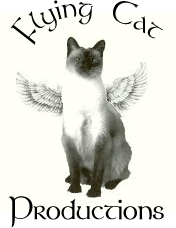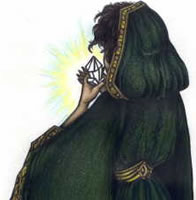Recent Shows
This newsletter is going to have to be a relatively short one. I just
got done with two weekends of shows, which is a lot of work. That, plus
stress at work, and the continued search for a better job, has left
me pretty tired. But I wanted to at least write something.
The first show we did was the Gibraltar Holistic Show, on the 20th
and 21st. Neither Laura nor I made as much money as we usually do at
a Gibraltar show. But Laura did make a profit, which was good. I did
not even cover my table cost...not so good. So, at first, I was bummed
out about that.
However, it was an enjoyable show, despite that. One of the vendors
passed out daffodils to all the other vendors, in honor of the first
day of Spring. Another vendor gave everyone a free seashell with her
business card and contact information. I thought that was such a nice
little gift! I still have my little spiral seashell on a dresser next
to my bed. And I got many compliments on my art, which I love.
The next weekend was the annual Rock Swap in Taylor, a show I always
enjoy, whether I make a profit or not. A woman who had attended the
Gibraltar show came to the Taylor show also. She really liked a jewelry
set I made, but did not have enough cash to buy it at Gibraltar. She
drove all the way from Rochester to Taylor to buy the set! With that
extra sale, I covered my table cost for the Gibraltar Holistic show.
Plus I did sell some jewelry and fossils at the rock swap. So I ended
up breaking even at the rock show, too.
One of the best things about the rock swap is that I always see fellow
rock hounds I know. Every year, my geology professor comes to the show,
sometimes with current students. And we get a chance to chat. Quite
a few members of MMS attend this show also. And you get to know your
fellow vendors, swap stories, & trade rocks. There are always wonderful
specimens to look at and purchase, some very hard to resist. And some
vendors have their stone & beaded jewelry, wire-wrapping, scrimshaw,
gem trees, and other rock-related art. It is always a fun show.
And there’s always interesting free info and newsletters to pick
up, too. There is a Rock Hound Weekend in June, offering all kinds of
classes and presentations, for a fairly reasonable price, that I’d
really love to attend. I have to dig out the flyer on it, and post the
info once I find out all the details.
I actually ran into a newsletter subscriber at the show also. Thanks,
Patty, for the kind words about my newsletter. It was great to talk
to you again!
So, in the end it turned out to be an enjoyable 2 weekends of shows.
Enjoyable, but tiring...
Blessings to all!
LL&P \\ //
~~~ Alicia
Introduction to Fluorescent Minerals
This year at the rock swap I bought 2 UV lights. I was only going to
get one, either short wave or long wave (mainly because of the price).
But after returning to my table at the end of the show and pondering
it for all of 3 minutes, I couldn’t stand it and had to get both.
(Thanks to ‘Joel the rock guy’ for giving me a discount! I
was very excited.) And it’s a good thing I did, too... Because
as some minerals will fluoresce under short wave, others will only fluoresce
under long wave, still others will fluoresce under both ultraviolet
wavelengths, sometimes exhibiting a different color for each.
Really basic explanation for fluorescence: Rocks are composed of minerals,
minerals are composed of chemical elements, and chemicals – like
everything else – are composed of atoms. Well, what an ultraviolet
light does to certain minerals, is it ‘excites’ particular
atoms in the mineral causing them to move extremely rapidly. The result
of this activity appears to us as a glow in the mineral, called
fluorescence. Pure minerals containing these excitable particles
may fluoresce under short or long wave UV light. Rocks containing fluorescent
minerals may fluoresce too.
There are, of course, exceptions to the fluorescent rule. Even minerals
which commonly fluoresce, such as Fluorite (its name even indicates
its fluorescent ability) and Calcite, may do so only under certain conditions.
Certain localities are known for there fluorescent minerals; New Jersey
is actually the “fluorescent mineral capital of the world”.
Fluorites from NJ regularly fluoresce, whereas Fluorite specimens from
another locality may not at all.
Even while testing my minerals and rocks, I found that one of my many
Fluorites exhibited fluorescence, but none of the others did.
Minerals that may exhibit fluorescence include: Adamite, Albite, Apatite,
Aragonite, Barite, Brucite, Calcite, Celestite, Corundum (Ruby), Fluorite,
Gypsum, Halite, Hanksite, Natrolite, Scapolite, Smithsonite, Sodalite,
Stillbite, Ulexite, Wavellite, and others.
That is a very quick and easy description for now. I really want to
read more about fluorescent minerals before I do a whole newsletter
about them. In my geology books, I only have a few pages dedicated to
this topic. And that is not enough information. The Michigan Mineralogical
Society has an entire book in their library all about fluorescent minerals.
I’m going to borrow it at the next meeting, next Monday, so I can
do April’s newsletter all about fluorescent minerals.
And I have to figure out how to take photos of the minerals while they
fluoresce with my digital camera, so I can have them on the archive
page. If this is even possible... We’ll see.
The Hadron SuperCollider
On March 30, in Geneva, Switzerland, the world’s largest atomic
supercollider set a new record. Scientists crashed proton beams into
each other at three times more power than ever before. They are hoping
that this achievement will reproduce on a tiny scale what theoretically
happened immediately following the Big Bang, the believed start
of the known universe. Now that would be cool. The Big Bang took place
approximately 14 billion years ago.
The mini super-collision of the proton beams also hopes to give more
insight into particle physics, the existence of anti-matter, and information
on the Higgs boson (which is a hypothetical particle that gives mass
to other particles & therefore other objects/beings in the Universe).
Also, very cool.
So far scientists are dismissing the fear that collisions such as this
could create micro black holes (collapsed stars on a subatomic level),
which could inadvertently suck the Earth, stars, and other celestial
bodies into their gravitational fields. Not so cool. Yeah, we definitely
wouldn’t want that to happen.... We have enough problems in the
world, without being accidentally devoured by a man-made miniature black
hole.
Read the article here: Hadron SuperCollider



